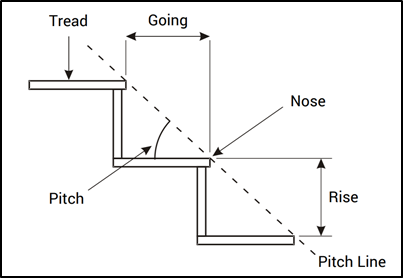Key points:
• Falls on stairs are common, and often lead to serious injuries.
• Falls on stairs are often complex – there are multiple possible factors that can cause a fall.
• Many stair incidents can easily be prevented, and remedial solutions implemented at minimal cost.
• Ultimately, however, steps and stairs should be designed and built properly, consistent with regulations and common practice, having regard for their purpose and use.
The ubiquitous steps and stairs found in all places of the community present a common fall risk. Each year in Australia, thousands of people are injured in their workplace, home or in a public space due to a fall involving stairs. While most of these injuries are preventable, it remains a fact that such incidents can and do often result in serious injuries or even death.
There are a number of factors that may contribute to a fall on stairs, including design, construction and use. This article will outline some of those factors to look out for when considering the safety of a set of stairs, and suggest practical ways that you can minimise risk of injury.
This advice is necessarily of a general nature only; we recommend that you obtain expert advice if the risk of a fall incident is high. If you are a manager or business owner, it is your legal responsibility to make sure stairs in your workplace are as safe as is reasonably practicable for you to make them.
What commonly causes falls on stairs?
Most falls on stairs occur due to one of the following:
- Slips occur when a person loses traction with the stair surface. The most common causes of slips, therefore, are insufficiently slip-resistant tread surfaces (e.g., surfaces that are highly polished, wet, worn carpet, smooth paint or greasy).
- Tripping occurs when a person unexpectedly catches their foot on part of the stairs. Typically, the objects that a stair user will trip on are small and unobtrusive such as a small lip, or a damaged “nosing” (the step edge). A trip can also occur due to inconsistent step sizing – we rely on uniformity in stairs, and can literally be “tripped up” when it is not provided.
- Mis-stepping occurs when a person oversteps a step or otherwise does not land one of their feet on the next level in the position expected. Our gait (the study of how we walk) is a fragile thing, and it is surprisingly easy to disturb it. Such mis-stepping incidents can often also occur due to dimensional inconsistencies, lack of contrast at the step edges, visual or lighting issues. They can also be caused by damaged steps or poorly maintained steps.
How to minimise slip, trips and falls on stairs
To minimise the risk of a slip or trip and fall on stairs, below are some key things to consider about stair safety, whether it is in a home, workplace or community space.
- Step geometry, the dimension of riser and goings (see diagram below) should be within acceptable limits – the National Construction Code provides a useful table of advice in this regard. “Riser and going” (step rise and run) dimensions should be constant through the flight.
- Is the stairway/stairwell well lit? Long established Australian Standards for lighting provide guidance for a whole host of usage situations.
- Is there good contrast along each the step edge? Is it easy to see that there is a step, and where it’s edge is?
- Is the surface material on the stairs slippery in either wet or dry conditions? Is it exposed to an area likely to get wet or greasy? Is it worn or contaminated with some other material, like powders? Are there surface irregularities? Does it give good traction? Australian Standards for surface slip resistance prescribe minimum requirements for surface coefficients.
- Is the nosing (the front edge of the step, see Figure 1 below) worn, raised and lifted (if there is a strip added) or showing signs of wear? Are there areas where a stair user’s toe or heel could catch?
- Are there handrails? Do they extend the full length of the stairs?
- Avoid single steps where possible – they can hide in plain sight.

Figure 1 – typical stair properties.
There are other behavioural factors that contribute to falls on stairs, like user fatigue, drug and alcohol use, distraction, carrying heavy or large loads, or sun in the eyes.
As independent safety and ergonomics experts, Dohrmann Consulting have investigated a diverse range of incidents involving stairs, and have also worked extensively with stair designers in ensuring designs meet the appropriate building codes and standards.
We leverage our experience gained from regularly providing expert opinion in stair incidents.
Free ‘Falls on Stairs’ Checklist
We have developed a ‘Falls on Stairs’ checklist that is intended to provide an investigator with guidance as to what to look for and what to ask an injured person when a fall on stairs has occurred. To obtain a copy of this checklist, please click here.
You may also be interested in the following information and resources:
- National Construction Code (NCC) Compliance: Expert Safety Advice and Performance Solutions
- Preliminary expert liability advice for legal practitioners
- How to minimise the most common workplace injuries in Australia
The post Preventing slips, trips and falls on stairs appeared first on Dohrmann Consulting.





















